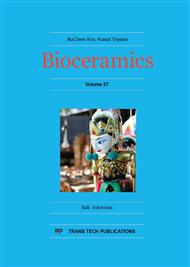p.145
p.151
p.157
p.161
p.165
p.171
p.177
p.183
p.187
Primary Stability of Uncemented Total Hip Stems with Different Ceramic and Titanium Surface Coatings
Abstract:
The necessity of coatings for endoprosthetic implants is discussed controversially. Thereby hydroxyapatite coatings are objects of the debate [1, 2]. Therefore, we investigated four different coatings (calcium-phosphate (CaP), titanium-calcium-phosphate (TiCaP), titanium-plasma-spray (TPS) and bilayer-composite calcium-phosphate (CaP-bc)) in comparison with rough uncoated test specimens to evaluate the impact of the osteoconductive coatings on the initial implant stability which is the key factor for its secondary stability. Dimensions of the test specimens were defined according to a conventional total hip stem and their geometry was simplified to a conical one for comparison of the surface-related parameters. The specimens were force-controlled pressed in artificial bone counterparts made of foam material while the displacement was monitored by the test machine to determine the subsidence behavior. Consecutively a displacement-controlled axial extraction of the test specimens was performed and the pull-out force was recorded. Roughness and geometry of the test specimens before testing were measured and correlated to type of coating and initial stability. The uncoated specimens showed highest extraction forces (3.9 kN) with moderate surface roughness compared to the coated specimens. In contrary to our assumption no correlation between surface roughness and the measured subsidence as well as pull-out force was found and a reduced subsidence or increased pull-out force for the different titanium and calcium-phosphate coatings could not be derived from the experimental tests.
Info:
Periodical:
Pages:
165-170
Citation:
Online since:
May 2016
Authors:
Keywords:
Price:
Сopyright:
© 2016 Trans Tech Publications Ltd. All Rights Reserved
Share:
Citation:


